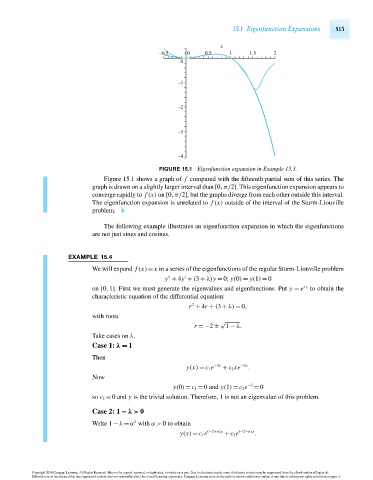Page 533 - Advanced engineering mathematics
P. 533
15.1 Eigenfunction Expansions 513
x
–0.5 0 0.5 1 1.5 2
0
–1
–2
–3
–4
FIGURE 15.1 Eigenfunction expansion in Example 15.3.
Figure 15.1 shows a graph of f compared with the fifteenth partial sum of this series. The
graph is drawn on a slightly larger interval than [0,π/2]. This eigenfunction expansion appears to
converge rapidly to f (x) on [0,π/2], but the graphs diverge from each other outside this interval.
The eigenfunction expansion is unrelated to f (x) outside of the interval of the Sturm-Liouville
problem.
The following example illustrates an eigenfunction expansion in which the eigenfunctions
are not just sines and cosines.
EXAMPLE 15.4
We will expand f (x)= x in a series of the eigenfunctions of the regular Sturm-Liouville problem
y + 4y + (3 + λ)y = 0; y(0) = y(1) = 0
on [0,1]. First we must generate the eigenvalues and eigenfunctions. Put y = e rx to obtain the
characteristic equation of the differential equation:
2
r + 4r + (3 + λ) = 0,
with roots
√
r =−2 ± 1 − λ.
Take cases on λ.
Case 1: λ = 1
Then
y(x) = c 1 e −2x + c 2 xe −2x .
Now
y(0) = c 1 = 0 and y(1) = c 2 e −2 = 0
so c 2 = 0 and y is the trivial solution. Therefore, 1 is not an eigenvalue of this problem.
Case 2: 1 − λ> 0
2
Write 1 − λ = α with α> 0 to obtain
y(x) = c 1 e (−2+α)x + c 2 e (−2−α)x .
Copyright 2010 Cengage Learning. All Rights Reserved. May not be copied, scanned, or duplicated, in whole or in part. Due to electronic rights, some third party content may be suppressed from the eBook and/or eChapter(s).
Editorial review has deemed that any suppressed content does not materially affect the overall learning experience. Cengage Learning reserves the right to remove additional content at any time if subsequent rights restrictions require it.
October 14, 2010 15:20 THM/NEIL Page-513 27410_15_ch15_p505-562

